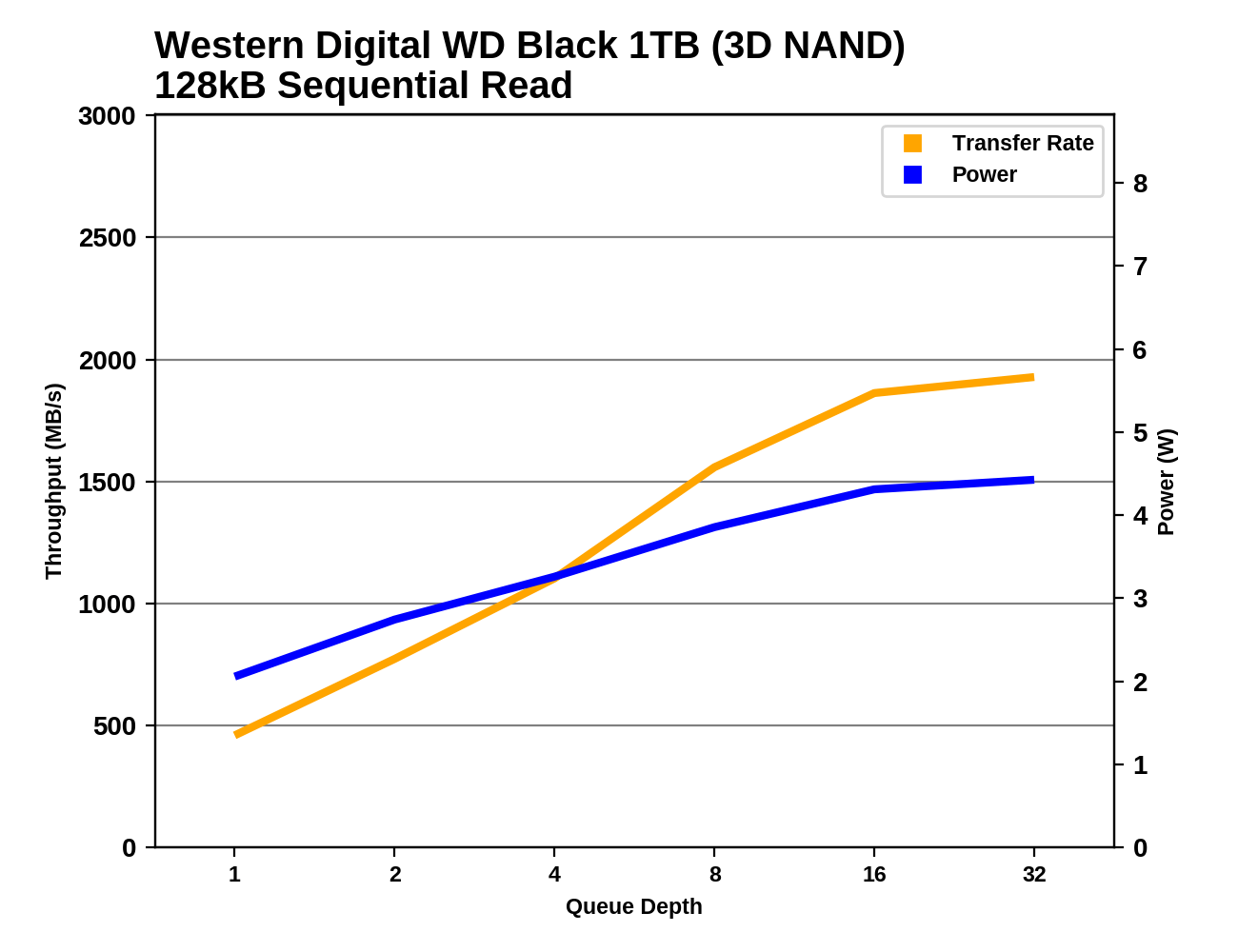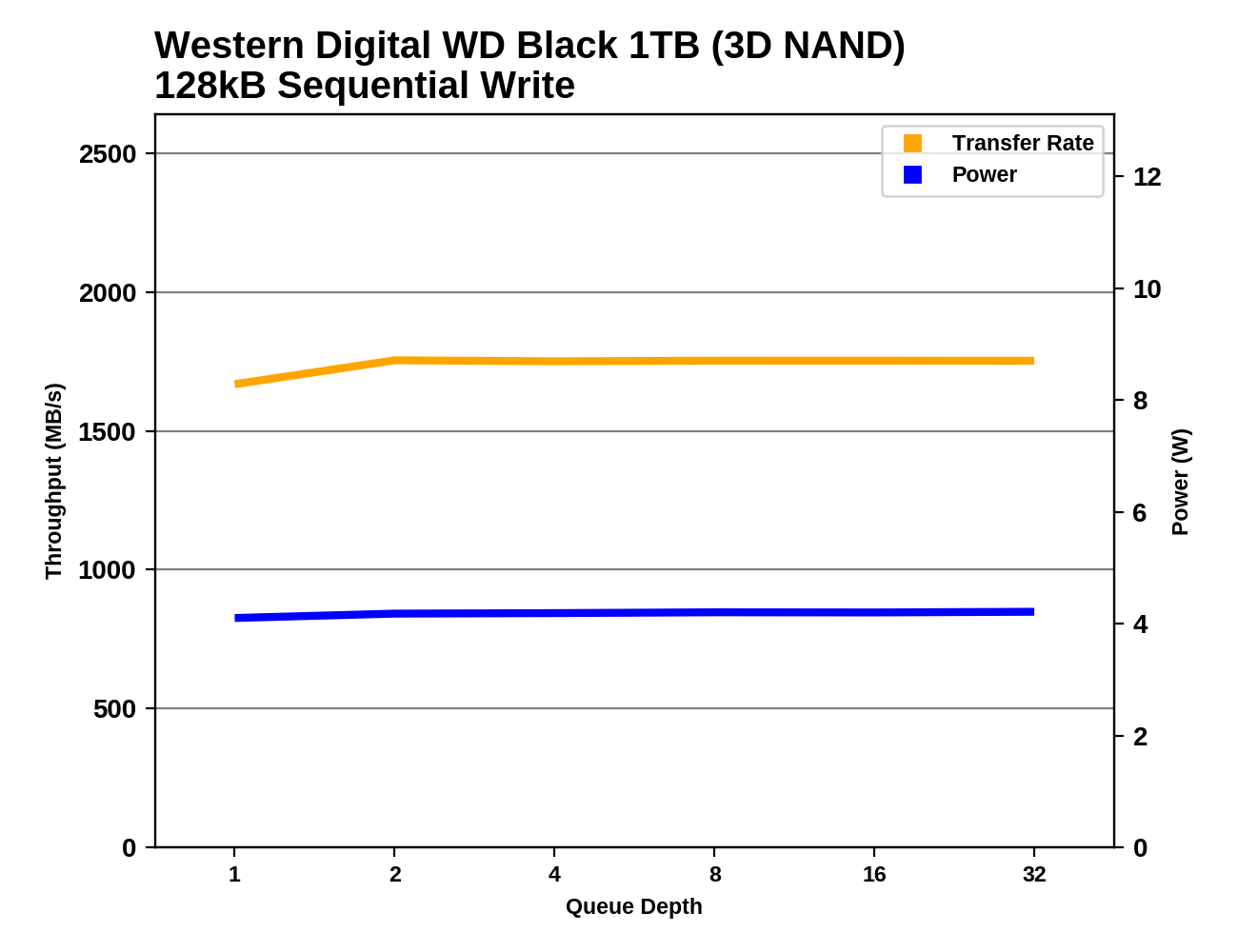The Western Digital WD Black 3D NAND SSD Review: EVO Meets Its Match
by Ganesh T S & Billy Tallis on April 5, 2018 9:45 AM EST- Posted in
- SSDs
- Storage
- Western Digital
- SanDisk
- NVMe
- Extreme Pro
- WD Black
Sequential Read Performance
Our first test of sequential read performance uses short bursts of 128MB, issued as 128kB operations with no queuing. The test averages performance across eight bursts for a total of 1GB of data transferred from a drive containing 16GB of data. Between each burst the drive is given enough idle time to keep the overall duty cycle at 20%.

The burst sequential read performance of the WD Black is several times higher than last year's model, but doesn't come close to setting any records.
Our test of sustained sequential reads uses queue depths from 1 to 32, with the performance and power scores computed as the average of QD1, QD2 and QD4. Each queue depth is tested for up to one minute or 32GB transferred, from a drive containing 64GB of data.

On the sustained sequential read test, the Samsung NVMe drives have a clear lead over the WD Black, which is tied with Toshiba's drives.
 |
|||||||||
| Power Efficiency in MB/s/W | Average Power in W | ||||||||
In terms of power efficiency for sequential reads, the WD Black is much closer to the top drives, with the exception of the Samsung 960 PRO.
 |
|||||||||
The sequential read performance of the WD Black starts out rather poor at QD1 but grows steadily all the way up to QD16, by which point it is outperforming everything except the Optane SSD. The Toshiba XG5 shows similar scaling behavior but can't quite keep pace with the WD Black.
Sequential Write Performance
Our test of sequential write burst performance is structured identically to the sequential read burst performance test save for the direction of the data transfer. Each burst writes 128MB as 128kB operations issued at QD1, for a total of 1GB of data written to a drive containing 16GB of data.

As with the burst random write test, our two samples show surprising differences in burst sequential write speeds. The difference amounts to the WD Black/SanDisk Extreme PRO either being tied for second place with the Samsung 960 EVO, or almost tied with the PM981 that the 960 EVO's replacement will be based on.
Our test of sustained sequential writes is structured identically to our sustained sequential read test, save for the direction of the data transfers. Queue depths range from 1 to 32 and each queue depth is tested for up to one minute or 32GB, followed by up to one minute of idle time for the drive to cool off and perform garbage collection. The test is confined to a 64GB span of the drive.

The sustained sequential write performance of the WD Black is not quite the best, but it is well ahead of everything except the best drives from Samsung and Intel. The WD Black is almost twice as fast as the Toshiba XG5 that uses essentially the same flash.
 |
|||||||||
| Power Efficiency in MB/s/W | Average Power in W | ||||||||
Despite not having the best performance on the sequential write test, the WD Black is the clear winner on the efficiency metric. With power draw of just over 4W it isn't close to being the least power-hungry drive, but it get so much done on that budget that the efficiency score beats everything else.
 |
|||||||||
The sequential write speed of the WD Black is quite steady across the range of queue depths, with just a small increase from QD1 to QD2 and no signs of degraded performance from excessive garbage collection after the SLC cache is full.










69 Comments
View All Comments
MajGenRelativity - Thursday, April 12, 2018 - link
Higher capacities can be made available at 2280 by using a double sided drive. As for IOPS performance, that can be calculated fairly easily, and I *think* Anandtech does that (I haven't read this review recently). I'm not sure what you mean about the drivers, or "Warranty period directly calculated based on the Endurance fures"oRAirwolf - Friday, April 13, 2018 - link
I would really love it if Anandtech had some common usage scenario load times for things like a large spreadsheet in Excel or how fast some modern games load. I would also be interested to know about things like Windows load time and time to wake up from sleep or hibernation. From what I have seen, all of these super fast nvme ssds don't really have a lot of impact on typical end-user usage scenarios like for office workers or gamers. I love bleeding edge tech and I always want manufacturers to push the limits of price and performance but it seems to me like a lot of people get wrapped around the axles about SSD performance when something like an 850 Evo and a 960 Pro will have almost identical load times in a game.